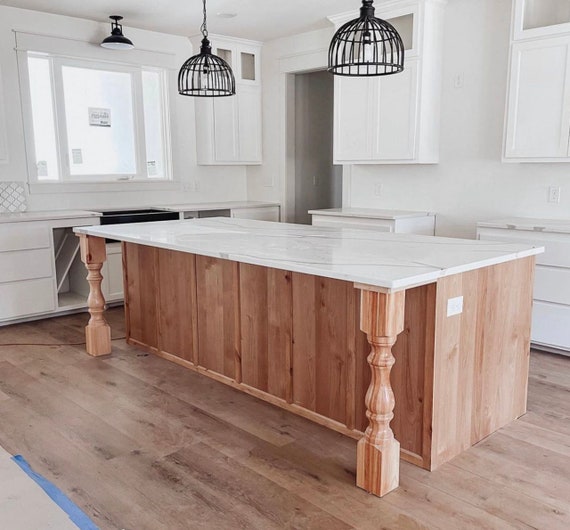Transform Your Kitchen's Look with One-of-a-kind Legs For Kitchen Island Accessories
Essential Factors to Take Into Consideration When Picking Legs For Kitchen Area Island
Selecting the proper legs for a cooking area island includes a mindful assessment of several factors that can significantly affect both capability and aesthetic charm. As we discover these elements, it comes to be clear that each choice can have significant implications for the total kitchen experience.
Material Options
When choosing legs for a cooking area island, understanding the different product alternatives is necessary for achieving both aesthetic charm and architectural honesty (Legs For Kitchen Island). The choice of material substantially affects not just the resilience of the island however also its overall style and capability
Wood is a preferred selection, offering warmth and adaptability. Strong woods, such as oak or maple, give strength and can be discolored or repainted to match the cooking area decor. Metal legs, typically made from stainless-steel or wrought iron, contribute a modern-day and commercial feeling while ensuring resilience and stability. These materials are immune to wear and can support substantial weight, making them perfect for larger islands.
Another alternative is engineered materials, like MDF or plywood, which can be extra cost-efficient while still offering a variety of surfaces. They might not provide the very same degree of stability as strong wood or metal. Legs For Kitchen Island. Last but not least, materials such as acrylic or glass can create a modern appearance, though they may call for extra support to ensure security.
Inevitably, the option of material for cooking area island legs must align with the wanted performance and the overall style of the kitchen area.
Style and Style

When taking into consideration design, the form and coating of the legs are important. Conical legs can supply a feeling of agility and style, while thicker, extra durable legs can share toughness and security. Furthermore, the surface-- be it painted, stained, or all-natural-- need to enhance the kitchen cabinetry and kitchen counter materials to create a unified look.
Moreover, the layout of the legs can additionally show personal taste. Custom or attractive legs, such as those including elaborate carvings or unique geometric forms, can act as centerpieces, including personality and character to the kitchen area. Ultimately, the appropriate option will not just improve functionality yet additionally raise the aesthetic allure, making the kitchen area island a standout feature of the home.
Elevation Considerations
Picking the suitable height for cooking area island legs is critical, as it directly affects both functionality and comfort. The standard height for a kitchen area island typically ranges from 36 to 42 inches, straightening with common countertop heights.

It is also important to account for users' elevations and preferences. Customizing the elevation can make sure a comfy experience for all member of the family, making the kitchen area island a much more functional and enjoyable space.
Weight Support
Making certain sufficient weight assistance for kitchen island legs is crucial for both safety and capability. The kitchen island usually serves numerous purposes, consisting of food preparation, dining, and added storage, demanding a durable assistance structure. When picking legs, it is essential to take into consideration the overall weight capability called for based on the island's meant usage and the materials that will be positioned on it.
The selection of material for the legs plays a considerable duty in their weight-bearing capabilities. Solid timber, steel, and durable composites typically supply superior stamina contrasted to lighter products. In addition, the design of the legs-- whether they are directly, tapered, or have a pedestal type-- can affect their capacity to distribute weight visit the site efficiently throughout the framework.
Always speak with the producer's specs concerning load limits to ensure that the legs can maintain the desired weight without jeopardizing security. In summary, selecting cooking area island legs with ample weight assistance is vital for creating a practical and safe cooking area.
Setup and Upkeep
Proper setup and maintenance of cooking area island legs are vital for ensuring durability and stability. This commonly involves protecting the legs to the island base using appropriate bolts, ensuring that the legs are degree and straightened.
Once mounted, regular maintenance is essential to preserve the integrity and appearance of the legs - Legs For Kitchen Island. For wood legs, periodic cleaning with a wet cloth and application of suitable timber gloss can prevent wetness damages and keep their surface. Steel legs may need a mild cleansing solution to eliminate oil and crud, followed by a dry fabric to stop corrosion development
Furthermore, check the legs routinely for signs of wear or damage, such as cracks or loosened joints. Tightening screws or bolts as needed can also prolong the lifespan of the legs. By click to find out more sticking to these installment and upkeep techniques, home owners can make certain that their cooking area island continues to be durable and aesthetically appealing for many years ahead.
Conclusion

Aesthetic comprehensibility is extremely important in selecting the design and style of legs for a cooking area island, as these components greatly influence the overall ambiance of the area. Tapered legs can offer a sense of lightness and sophistication, while thicker, a lot more durable legs can convey strength and stability.Choosing the appropriate height for kitchen island legs is essential, as it directly impacts both functionality and comfort. In recap, picking cooking area island legs with ample weight assistance is essential for creating a safe and useful cooking area.
In conclusion, selecting legs for a kitchen island demands mindful factor to consider of different elements, including material options, design, elevation, weight assistance, and installment.